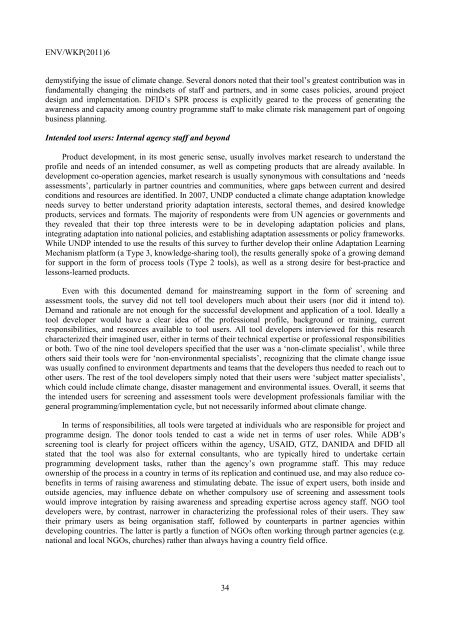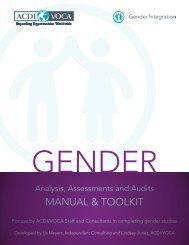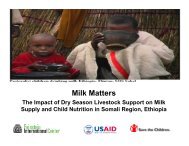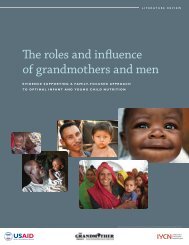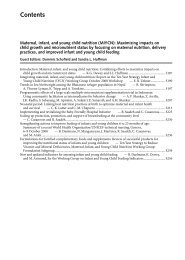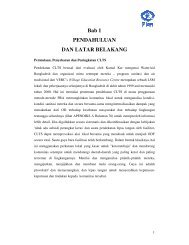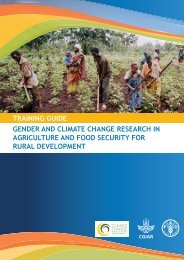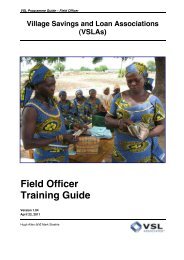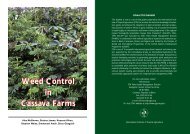Harmonising Climate Risk Management - International Institute for ...
Harmonising Climate Risk Management - International Institute for ...
Harmonising Climate Risk Management - International Institute for ...
- No tags were found...
You also want an ePaper? Increase the reach of your titles
YUMPU automatically turns print PDFs into web optimized ePapers that Google loves.
ENV/WKP(2011)6demystifying the issue of climate change. Several donors noted that their tool’s greatest contribution was infundamentally changing the mindsets of staff and partners, and in some cases policies, around projectdesign and implementation. DFID’s SPR process is explicitly geared to the process of generating theawareness and capacity among country programme staff to make climate risk management part of ongoingbusiness planning.Intended tool users: Internal agency staff and beyondProduct development, in its most generic sense, usually involves market research to understand theprofile and needs of an intended consumer, as well as competing products that are already available. Indevelopment co-operation agencies, market research is usually synonymous with consultations and ‘needsassessments’, particularly in partner countries and communities, where gaps between current and desiredconditions and resources are identified. In 2007, UNDP conducted a climate change adaptation knowledgeneeds survey to better understand priority adaptation interests, sectoral themes, and desired knowledgeproducts, services and <strong>for</strong>mats. The majority of respondents were from UN agencies or governments andthey revealed that their top three interests were to be in developing adaptation policies and plans,integrating adaptation into national policies, and establishing adaptation assessments or policy frameworks.While UNDP intended to use the results of this survey to further develop their online Adaptation LearningMechanism plat<strong>for</strong>m (a Type 3, knowledge-sharing tool), the results generally spoke of a growing demand<strong>for</strong> support in the <strong>for</strong>m of process tools (Type 2 tools), as well as a strong desire <strong>for</strong> best-practice andlessons-learned products.Even with this documented demand <strong>for</strong> mainstreaming support in the <strong>for</strong>m of screening andassessment tools, the survey did not tell tool developers much about their users (nor did it intend to).Demand and rationale are not enough <strong>for</strong> the successful development and application of a tool. Ideally atool developer would have a clear idea of the professional profile, background or training, currentresponsibilities, and resources available to tool users. All tool developers interviewed <strong>for</strong> this researchcharacterized their imagined user, either in terms of their technical expertise or professional responsibilitiesor both. Two of the nine tool developers specified that the user was a ‘non-climate specialist’, while threeothers said their tools were <strong>for</strong> ‘non-environmental specialists’, recognizing that the climate change issuewas usually confined to environment departments and teams that the developers thus needed to reach out toother users. The rest of the tool developers simply noted that their users were ‘subject matter specialists’,which could include climate change, disaster management and environmental issues. Overall, it seems thatthe intended users <strong>for</strong> screening and assessment tools were development professionals familiar with thegeneral programming/implementation cycle, but not necessarily in<strong>for</strong>med about climate change.In terms of responsibilities, all tools were targeted at individuals who are responsible <strong>for</strong> project andprogramme design. The donor tools tended to cast a wide net in terms of user roles. While ADB’sscreening tool is clearly <strong>for</strong> project officers within the agency, USAID, GTZ, DANIDA and DFID allstated that the tool was also <strong>for</strong> external consultants, who are typically hired to undertake certainprogramming development tasks, rather than the agency’s own programme staff. This may reduceownership of the process in a country in terms of its replication and continued use, and may also reduce cobenefitsin terms of raising awareness and stimulating debate. The issue of expert users, both inside andoutside agencies, may influence debate on whether compulsory use of screening and assessment toolswould improve integration by raising awareness and spreading expertise across agency staff. NGO tooldevelopers were, by contrast, narrower in characterizing the professional roles of their users. They sawtheir primary users as being organisation staff, followed by counterparts in partner agencies withindeveloping countries. The latter is partly a function of NGOs often working through partner agencies (e.g.national and local NGOs, churches) rather than always having a country field office.34


